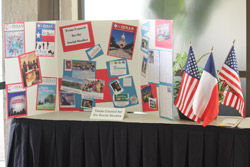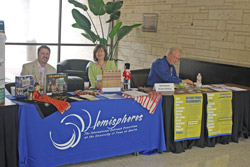2011 Austin
CTAUN Conference
Austin, 2 April 2011
University of Texas, Austin, TX
GLOBAL-LOCAL PARTNERSHIPS FOR THE 21st CENTURY: A UN COLLABORATIVE
Welcome
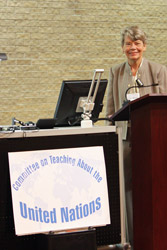 Anne-Marie Carlson, Chair of CTAUN and the Conference Chair, welcomed the participants, and then introduced CTAUN’s Conference partner, Delta Kappa Gamma, the International Society of Women Educators. She thanked members of the Steering Committee, and the staff of the University of Texas at Austin for helping to secure the venue, for their involvement in the planning, and for sharing their programs at this Conference.
Anne-Marie Carlson, Chair of CTAUN and the Conference Chair, welcomed the participants, and then introduced CTAUN’s Conference partner, Delta Kappa Gamma, the International Society of Women Educators. She thanked members of the Steering Committee, and the staff of the University of Texas at Austin for helping to secure the venue, for their involvement in the planning, and for sharing their programs at this Conference.
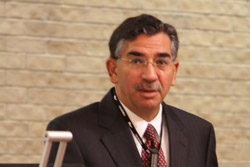 Ms. Carlson introduced Dr. Richard Flores, Senior Associate Dean for Academic Affairs for the College of Liberal Arts, and professor of anthropology and Mexican American Studies at UT. Dr. Flores welcomed all on behalf of the University and emphasized that we must rethink “local” to be an amalgam or mixture of global elements. We also must reframe our thinking on social, political and economic issues. Although many differences among people and nations are disappearing in our modern technological world, some remain. The sure way to make a difference in changing ideas is through education.
Ms. Carlson introduced Dr. Richard Flores, Senior Associate Dean for Academic Affairs for the College of Liberal Arts, and professor of anthropology and Mexican American Studies at UT. Dr. Flores welcomed all on behalf of the University and emphasized that we must rethink “local” to be an amalgam or mixture of global elements. We also must reframe our thinking on social, political and economic issues. Although many differences among people and nations are disappearing in our modern technological world, some remain. The sure way to make a difference in changing ideas is through education.
Opening Keynote
Ramu Damodaran
Deputy Director for Partnerships and Public Engagement in the United Nations Department of Public Information’s Outreach Division, with responsibility for the ACADEMIC IMPACT initiative.
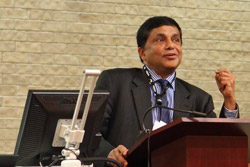 Mr. Damodaran began his remarks on educational sustainability and the need for global-local partnerships by stating that global issues demand a local response. He referred to education as a two-fold task of generating knowledge and reconciling it with what people want to believe; he gave examples of famous people – Galileo and Isaac Newton – whose ideas clashed with what the public wanted to believe.
Mr. Damodaran began his remarks on educational sustainability and the need for global-local partnerships by stating that global issues demand a local response. He referred to education as a two-fold task of generating knowledge and reconciling it with what people want to believe; he gave examples of famous people – Galileo and Isaac Newton – whose ideas clashed with what the public wanted to believe.
He spoke of the three I’s of how we learn – intuition, inference and instruction – to which he added imagination and immediacy. He referred to the imaginative response of a local eight-year-old girl who asked that in lieu of gifts for her birthday, guests donate money to CARE. He also cited the “Schools for Africa Project,” a collaboration between DKG and the US Fund for UNICEF, as a way to create the link between the ideal and what’s happening locally. He pointed out that AUSTIN is really an acronym for – Action to Unite Students and Teachers in the Now – and challenged Austin teachers to forge a link between the traditional ideas of American education and the immediate needs of what is occurring now in Japan, North Africa, and the Middle East. “Global is here; local is everywhere,” he said.
Mr. Damodaran concluded by posing several questions: Will education as an industry survive? He believes it cannot be sustainable if it is limited to an externally imposed curriculum. Is education delaying career prospects as it currently exists? Is there an imbalance between what institutions see as necessary and what individuals feel they need? He believes that education must be something that people elect and that we must look at the needs of communities of learners rather than their identities. He gave as examples, “Unlearning Intolerance” seminars at the UN and the Alliance of Civilizations, both of which attempt to engage citizen learners in societal change.
Morning Panel – an Overview of the Issues
Moderator, Kathy Obenchain, University of Texas, introduced the panelists.
Linda Brucker
founder of “A Legacy of Giving”
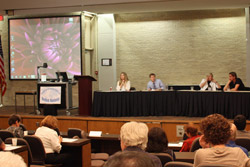 Ms. Brucker illustrated how her program is an Educational Trend. She has created a classroom-based model which teaches children philanthropy, encouraging them to become involved in improving their communities and the world. Ms. Brucker emphasized that her program is linked to many subjects of the curriculum, especially math, science, geography and language arts. It is delivered by helping the students visualize a need of the community, working within the curriculum to discover information, and planning service projects to help solve the problem. Students are encouraged to focus on the possible gifts of their time, their talent or their treasure. Currently, there are 35 schools and 7,000 students participating in a program called “The Drive for Coats and Cans.” The Spring semester of 2012 will focus on a “Walk to Water.” The presentation ended with a short video showcasing children who are participating in the current program.
Ms. Brucker illustrated how her program is an Educational Trend. She has created a classroom-based model which teaches children philanthropy, encouraging them to become involved in improving their communities and the world. Ms. Brucker emphasized that her program is linked to many subjects of the curriculum, especially math, science, geography and language arts. It is delivered by helping the students visualize a need of the community, working within the curriculum to discover information, and planning service projects to help solve the problem. Students are encouraged to focus on the possible gifts of their time, their talent or their treasure. Currently, there are 35 schools and 7,000 students participating in a program called “The Drive for Coats and Cans.” The Spring semester of 2012 will focus on a “Walk to Water.” The presentation ended with a short video showcasing children who are participating in the current program.
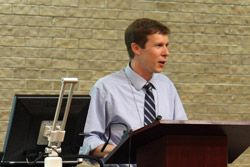
Dr. Michael Anderson
lecturer in International Relations and Global Studies, UT
spoke about Social Justice, especially two global protest movements: the anti-austerity movement in Europe, and the political uprisings in the Middle East.
Since the global economic collapse of 2008, nations of the Euro Zone have been cutting social services, pensions, freezing public sector employment, and resorting to other drastic measures in order to stave off the financial collapse that has threatened Greece, Ireland, and Portugal. While this has been derided in the media in some cases as “Europe’s social welfare project coming to an end,” certain groups are disproportionately affected by these cuts. The loss of services amounts to real financial hardship, and so the demonstrations in London that wanted to “turn Trafalgar Square into Tahrir Square” have social justice at their core. In the protests that toppled the governments of Tunisia and Egypt, politics and the lack of democratic freedoms were identified by the media as the primary motives of the demonstrators and activists; however, economic concerns such as the high cost of food and record unemployment played an equally important role. Dr. Anderson suggested that while these two movements may appear to be political in nature, the desire for social justice should not be ignored. He concluded by saying that he believes that the Age of Austerity might also be the Age of Possibility.
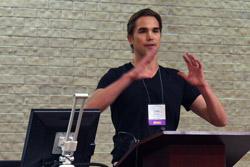
Zane Wilemon
founder and executive director of “Comfort the Children”
showed how this program relates to Sustainability. He framed the story of his life-journey with the questions, “What do I believe in?” and “Who would I be if there was no one who knew me?” He shared the experiences in Kenya which forged his current thinking. Working in an extremely poor village, he discovered that a community is “relational,” that its members learn from each other. He also learned that poverty is complicated. Finally, he believes that a holistic approach is necessary for the success of any venture. In response to a student’s question, Mr. Wilemon said that the student should use his imagination, find a passion, and act on it by starting a club, such as a classroom-to-classroom sharing with students in Africa or elsewhere.
Breakout Sessions
Educational Trends – Philanthropic Education
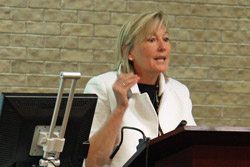
Linda Brucker
of “A Legacy of Giving”
was assisted by Shana Burg, Academic Program Director. Together they built on what was said in the morning panel, by taking the attendees through a lesson plan for introducing children to the concept of philanthropy. They began by analyzing words, such as community and philanthropy, looking at their root meanings. Then they differentiated between acts of kindness and philanthropy; they determined that the latter requires research, that it must be continued over a period of time, and that it must have social impact. They also showed the difference between prevention and band-aid solutions; for example, a food pantry is “band-aiding” and teaching people to start a garden is prevention. The components of philanthropy include finding your passion, researching the topic, and taking action.
School districts apply to be part of a project and an Academic Project Director is assigned at the 4,5,6,9, and 12th grade levels. Teachers are sent to a half or whole day training session. The focus of the first six months of a project is local, the latter six months is global.
Social Justice – Human Trafficking
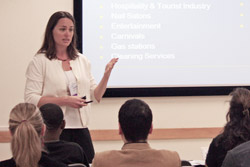
Laurie Cook Heffron and
Maria Andrea Pinales
represented the Central Texas Coalition Against Human Trafficking
a group that brings together various agencies to combat trafficking and support its victims. The session began with the video, “Human Trafficking is Modern Day Slavery.” The Trafficking Victims Protection Act of 2000 defines trafficking as the “recruitment, harboring, transportation, provision or obtaining of a person for labor or services, through the use of force, fraud or coercion, for the purpose of subjection to involuntary servitude, peonage, debt bondage, slavery or forced commercial sex acts.” In the presentation, examples of force, fraud and coercion were given.
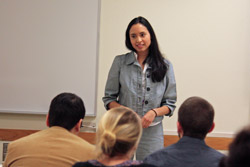 Ms. Heffron and Ms. Pinales then asked and answered the questions: What does human trafficking look like in Central Texas? Who are the victims? They gave statistics; they showed the difference between trafficking and smuggling; they described the psychological effects on victims and what trafficking looks like in a neighborhood – heavy traffic, especially male, in one house; many young women living in one house who are always transported as a group; and “maids” who never leave the home. Trafficking is a “hidden” crime; it is difficult to find the victims and prosecute the offenders, so we can help by spreading the word and fundraising.
Ms. Heffron and Ms. Pinales then asked and answered the questions: What does human trafficking look like in Central Texas? Who are the victims? They gave statistics; they showed the difference between trafficking and smuggling; they described the psychological effects on victims and what trafficking looks like in a neighborhood – heavy traffic, especially male, in one house; many young women living in one house who are always transported as a group; and “maids” who never leave the home. Trafficking is a “hidden” crime; it is difficult to find the victims and prosecute the offenders, so we can help by spreading the word and fundraising.
Sustainability – Community Development
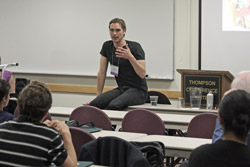
Zane Wilemon
of Comfort the Children
interpreted the theme of Sustainability as community development and empowering the impoverished. He began by showing some videos about his organization and its volunteers; he partners with organizations in Austin and other locales. He recounted a story to show how CTC works in Kenya. He was told about a group of about 150 persons with special needs. They were hidden away because of the social stigma (their mothers were thought to have sinned) and there were no schools or other services for them. Comfort the Children built them a school. Then the mothers had free time, so they were taught how to sew and put their talents to work making recyclable bags, called “life bags.”
He continued by saying that sustainability involves helping people day by day, empowering citizens, and he believes there are five basic needs for a community to grow and be sustainable – education, environment, community, health and economy. He also believes that attitude is important. Volunteers must steer clear of the colonial approach; all volunteer work must be a sharing. He believes that providing hope through relationships and using a holistic approach to building community is empowering our world.
Educational Trends – Model UN
Theresa McCorquodale
brought students from the Academy for Global Studies in Austin High School.
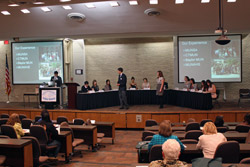 The students described the process which precedes their actual appearance at a model UN conference. Each student is assigned a country to represent and a committee to be a member of. They must do research for both background information and to find out how “their” country would actually vote at a UN session. They must practice public speaking, and learn problem solving and cooperation. Then they must present a position paper explaining the country’s opinion on or possible solutions for a topic from the past or present.
The students described the process which precedes their actual appearance at a model UN conference. Each student is assigned a country to represent and a committee to be a member of. They must do research for both background information and to find out how “their” country would actually vote at a UN session. They must practice public speaking, and learn problem solving and cooperation. Then they must present a position paper explaining the country’s opinion on or possible solutions for a topic from the past or present.
At an actual debate, the delegates present their position papers and the major concerns and ideas of the countries. Then the debate begins, and alliances start to form; it is an unmoderated caucus. Sometimes a resolution is passed; sometimes a resolution is amended. Finally, the students presented a mock UN conference, much to the delight of everyone present.
Social Justice – Global Racism
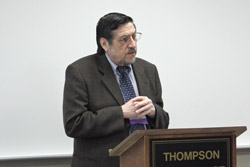
Dr. Richard Valencia
Professor of Educational Psychology at UT
Dr. Valencia focused on one aspect of social justice by framing the title of his presentation as a question: Do global differences in intelligence explain variations in the wealth of nations? He referred his listeners to his award-winning book: Dismantling Contemporary Deficit Thinking: Educational Thought and Practice. He indicated the flaws in popular scientific theories of the past. Scientific racism is the use of pseudoscience to support the idea of white superiority; students of color are blamed for school failure because of their genes, culture or lack of socialization. He believes social justice seeks equality and a voice for the marginalized. He cited the 1950 UNESCO statement that concludes “The range of mental capacities in all ethnic groups is much the same.”
Dr. Valencia traced the history of other “isms” that offered reasons for difference in intelligence, noting that the idea of white superiority is currently widespread on the Internet. He pointed out flaws in researching technique and data, cautioning all those present to research the beliefs and ideas of both the author and publisher of a controversial book, and to question “scientific” data. He concluded that research on racial differences in intelligence has little scientific value and often leads to socially pernicious conclusions. He ended by saying that we must provide equal educational opportunities.
Sustainability – Assisting the Poor
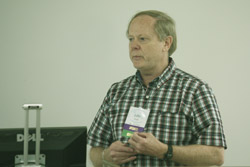
John Rudd
president of PET (Personal Energy Transportation)
Mr. Rudd began his company in 2008 as a branch of PET International, which was originally founded by a missionary with an engineering background. The organization strives to give the gift of mobility to 22 million people who have lost their legs; he offered the chilling statistic that 144 people a day are wounded by land mines. PET Austin is faith-based, volunteer and non-profit, sustained by contributions from individuals and organizations, such as Rotary. A PET is an off-road wheelchair, build solidly with rubber tires, welded frame and heavy wood; it is designed to withstand unmaintained roads (with potholes) in developing countries. The vehicles are built by volunteers and shipped to 90 countries.
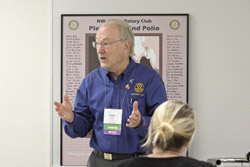
Kent Miller
Northwest Austin Rotary Club
Mr. Miller highlighted two projects sponsored by the Club. One project aims at eradicating polio in the world. President FDR is probably polio’s most famous victim. When the disease ravaged this country in 1958, there were 56,000 cases reported. The March of Dimes raised millions of dollars in dimes to help find the cure; the Salk vaccine was approved in 1955. Polio exists today in Pakistan, Afghanistan, India and Nigeria with 874 reported cases in 2010. Rotary is working to eliminate the disease completely.
The second program, Building Peace and Reconciliation, aims at training a new generation of World Peace Fellows in seven world centers where students can get a Masters Degree or Professional Development Certificate in conflict resolution. Applicants must have a Bachelors degree, proficiency in two languages and three years of work experience.
Afternoon Panel
Rapoport Service Scholars, University of Texas
Carlos Eric Bowles
Program Coordinator for the Rapoport Service Scholarship Program
presented information on the UT Rapoport Foundation and Scholarships Program. The program awards $10,000 scholarships to 12 sophomores for three years. Students take special courses in Leadership, Ethics and Society, Civic Engagement and Civic Responsibility; they design social action projects. Students must complete two hundred hours of community service each summer. This helps to empower the students to ask why and how they can make changes in our country and other countries. Three students spoke about their experiences.
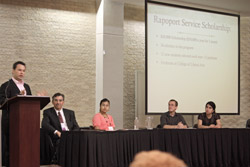
Lucy Alejos
Ms. Alejos did her “service learning” in Ghana and after working with young women there, she realized that the girls in the high school that she graduated from here had many of the same problems; she plans to spend her summer helping them.
Bruce Martin
talked about making connections between experience and formal learning, and between people. He believes in promoting both social action and scholarship.
Tamilla Mirzoycva
believes that students who are innovative and creative must be encouraged since they are valuable citizens.
Closing Keynote
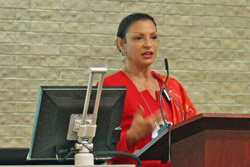
Teta Banks
Honorary Consul General of the Republic of Liberia
chose “Globalization in Education: Preparing World Citizens” as her topic. She began by quoting Charles Dickens in his novel, A Tale of Two Cities. “It was the best of times, it was the worst of times, it was the age of wisdom, it was the age of foolishness…it was the spring of hope, it was the winter of despair.” She applied this to our own current situation, saying that our world is changing and is fraught with many contrasts: poverty and prosperity, despair and freedom. She believes that all educational experience should work toward peace and that American education is challenged to develop world citizens.
She cited the experience of the Chilean miners who showed the world the value of collaborative effort. They built a voluntary social structure that included physical, spiritual and nutritional components; she saw this an application of social science as was her personal experience with a fellow student who believed in apartheid, and her work with the Truth and Reconciliation Commission in Liberia that dealt with war crimes in Liberia.
She believes in a Global Classroom, and in “International Liberal Arts” education. She mentioned the 12th annual Global Classrooms International Model UN Conference on May 12-14. She urged teachers to be vigilant in preparing and protecting their students and giving them a regard for the value of humanity, referring to Dr. Martin Luther King, Jr.’s idea of a “world house.” In conclusion, she hoped that in the words of Dickens, the winter of our despair would be turned into the spring of hope.
An Infofair during the lunch hour provided additional information for conference participants.
